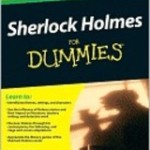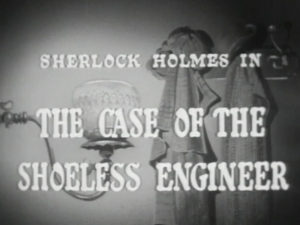A Scion Society of The Baker Street Irregulars

Data! Data! Data! – The Engineer’s Thumb
“‘Data! Data! Data!‘ he cried impatiently. ‘I can’t make bricks without clay.’”
– The Adventures of The Copper Beeches (COPP)

This column is composed of material (Data!) developed for a short course called Appreciating Sherlock Holmes that I teach twice a year in the Community Education Life Enrichment Program for a local community college. It is composed of “points of information” that are common to many / most / all of the 60 Canonical stories.
The information here has been researched by me or borrowed / stolen from many efforts of other Sherlockians.
ENGR is pretty low on everyone’s “favorites” list but that hardly limits discussion. One Sherlockian society has even produced a “Mythbusters” type video built around “the thumb.”
HERE GOES This month’s story The Adventure of the Engineer’s Thumb
CHRISTOPHER MORLEY SAID . . .
“One of the railway men at Paddington Station brought this case to Dr. Watson, and the good doctor after treating the wounded engineer referred the mystery to Holmes. (This was the story that so excited Stevenson’s overseer in Samoa.) By the time they reached the scene of the outrage there was nothing Holmes could do, but Watson always felt a special pride in having started the investigation.”
 DUMMIES SHORT SUMMARY (From Sherlock Holmes for Dummies by Steven Doyle & David Crowder) says “One of the grisliest Holmes stories relates Victor Heatherley’s unfortunate encounter with a meat cleaver.”
DUMMIES SHORT SUMMARY (From Sherlock Holmes for Dummies by Steven Doyle & David Crowder) says “One of the grisliest Holmes stories relates Victor Heatherley’s unfortunate encounter with a meat cleaver.”
PUBLISHING HISTORY
- This is the 11th of the 60 stories published.
- In England, it was published in The Strand Magazine in March, 1892.
- It was part of The Adventures of Sherlock Holmes collection published by George Newnes, Ltd., London, 1892 and Harper Bros., New York, 1892.
- The British illustrator was Sidney Paget.
HOW MANY WORDS?
According to C. E. Lauderback, 1960 – – found on the SHERLOCKIAN.NET website of Chris Redmond, at 8,342 words ENGR has the 34th most words (#1 is VEIL – 4,499, #56 if NAVL – 12,701)
THE BEST OF SHERLOCK HOLMES (How do Sherlockians rate this story?)
1999 – The Baker Street Irregulars ranked it 42nd of the 56 short stories
1999 – Sherlock Holmes Society of London voted it 50th of the 56 short stories
CLASSIFYING THE CASE (From the Wandering Gipsies of Grimpen Mire of Decatur, Alabama)
This case is one of forgery where Holmes provided the correct solution but the forgers successfully fled the police.
CHRONOLOGICALLY SPEAKING
Doyle was often very vague about stating WHEN the tale took place and included few contemporary references to help. Whether this was done intentionally or unthinkingly, the dating of events in the Canon is a very popular pastime pursued by several of our “scholars” researching and justifying their results to no end. We will again default to William Baring-Gould’s dating of Saturday, September 7 to Sunday, September 8, 1889 – making it 26th of the 60 stories in time. This would make Holmes 35 and Watson 37.
WHAT ELSE HAPPENED IN YEAR 1889?
It is always interesting to see what else in happening at the same time as the stories.
- British South Africa Company Charter awarded.
- Transvaal claimed to be “encircled” by Rhodes’ concessions in East Africa. Rhodesia is established.
- Great London Dock Strike
- Early use of photographs in newspaper: Illustrated London News runs Cambridge and Oxford boat crews.
- Act to prevent cruelty to children.
- Establishment of the telephone company.
- The Moulin Rouge first opens its doors in Paris.
- North and South Dakota, Montana and Washington admitted as U.S. states.
- Treaty of Acciali: Ethiopia was made Italian protectorate.
- End of Portuguese Empire in Brazil; republic proclaimed.
- Paris Exhibition: proof of industrial development in France.
- Work on Panama Canal stopped; French company bankrupt.
- Bismarck introduces Old Age Insurance in Germany.
- Erection of Tacoma Building in Chicago. First skyscraper, 13 stories high.
- Conan Doyle publishes A Sign of Four.
- Mark Twain publishes A Connecticut Yankee in King Arthur’s Court.
- Robert Louis Stevenson publishes Master of Ballantrae.
- Renoir paints Girls Picking Flowers.
- Van Gogh paints Man with a Pipe (self-portrait).
- Tschaikovsky introduces The Sleeping Princess ballet music.
- Richard Strauss introduces Tod und Verklrung, tone poem.
- Eiffel Tower completed, 985 feet high, taller than the Great Pyramid, become highest structure on earth.
- Hollerith’s punched-card system widely used in industry.
- Eastman’s Kodak camera comes into production, using photographic film.
- First linotype machine in use.
- Panhard and Levassor begin using Daimler’s engines in French cars, using modern layout.
HOLMES AND WATSON – PERSONAL INFO
During this tale, Watson is practicing medicine and living with his wife. Watson continually visited Holmes and “occasionally even persuaded him to forgo his Bohemian habits so far as to “come and visit us.”
DRAMATIS PERSONAE
- VICTOR HATHERLY, a hydraulic engineer of Victoria St.
- RAILWAY GUARD, patient of Watson who brought the engineer to him.
- COLONEL LYSANDER STARK aka FRITZ, counterfeiter and attempted murderer.
- BECHER aka MR. FERGUSON, accomplice of Stark who owned the mansion where the press was located.
- ELSIE, countrywoman of Stark
- JEREMIAH HAYLING, another hydraulic engineer who had disappeared one year before without a trace.
- INSPECTOR BRADSTREET, of the yard who accompanied Holmes et al to Eyford in Berkshire.
- PLAINCLOTHESMAN, assistant to Bradstreet.
- VENNER & MATHESON, firm to which Hatherly had been apprenticed.
“QUOTABLE SHERLOCK”
Possibly the least quoted story in the Canon, we can only offer this . . .
- “Experience,” said Holmes, laughing. “Indirectly it may be of value, you know; you have only to put it into words to gain the reputation of being excellent company for the remainder of your existence.”
HOLMES’ FEE
Evidently not a pound or pence in this story nor in his pocket as Holmes’ client was broke.
SHERLOCK ON THE BIG SCREEN & THE LITTLE SCREEN
Our tale not only lacking good quotes, but has rarely been on screen.
- 1923 The Engineer’s Thumb was one of Eille Norwood’s short movies.

- 1955 The Case of the Shoeless Engineer was the 12th episode of the series starring Ronald Howard as Holmes
- 1986 The Twentieth Century Approaches (which combined ENGR and SECO) had Vasily Livanov in the Russian The Adventures of Sherlock Holmes and Doctor Watson
- 2001 The Adventure of the Engineer’s Thumb was an episode of the Sherlock Holmes in the 22nd Century (Animated TV Series)
SHERLOCK HOLMES IN DISGUISE
The Master of disguise used the deception of being disguised 14 times in 11 of the 60 stories but did not use on in this story.
UNRECORDED CASES (That involved Holmes)
Watson would tease / torture his readers with “I know something you don’t.” Oh my, how Sherlockians love this category. I have over 150 examples in my collection. This month’s take gives us one.
- Colonel Warburton’s madness
IS THERE A DOCTOR IN THE HOUSE?
Victorian London, in the Holmes’ time, had approximately 1 doctor for every 100 people. 31 of the 60 tales have a doctor in them. This, of course, does not count Holmes’ Boswell. This listing is by Leslie Klinger in the Winter, 2015 edition of the Baker Street Journal. Whether it was Doyle or Watson, a doctor wrote the story. In this story there was no doctor involved or mentioned.
FAINTING IN THE CANON (courtesy of Sherlockian Karen Murdock)
Fainting is extremely common in the Canon, appearing, in some form, in 37 of the 60 tales. In 21 cases someone actually faints. And in 5 cases someone pretends to faint. In this month’s story Victor Hatherly definitely faints as well as almost faints in this tale.
HOLMES’S PUBLISHED & PROJECTED WORKS
Sherlockians love this topic and are regularly searching for these items. Holmes mentions published or projected works in 11 of the stories, but not in this one.
NEWSPAPERS (Real and Fictional)
Though included in only 20 tales, some of our more obsessed Sherlockians are very fond of this topic. Early in this tale, Holmes is reading the agony columns of The Times.
ANNOTATED SHERLOCK
The 60 Sherlock Holmes stories used English as spoken in England from the 1880’s until the 1910’s. Some words are foreign to us today and need a “contemporary translation.”. For example:
- “fuller’s earth” A sedimentary clay which has the property of absorbing basic colors. It is chiefly used in clarifying petroleum and refining edible oils.
- “carbolized bandages” bandaged impregnated with carbolic acid or phenol. The compound’s use as an antiseptic was popularized by Joseph Lister.
- “rashers” thin slices of bacon or ham, broiled or fried.
- “chinchilla beard” A beard gathered into tufts, resembling the fur of an animal. While the origin of the phrase is unknown, this limerick has achieved popularity:
When the catch a chinchilla in Chile,
They cut off its beard, willy-nilly,
With a small razor blade,
Just to say that they’ve made,
A Chilean chinchilla’s chin chilly.
- “indiarubber” natural rubber.
- “coiners” forging coins was a large criminal industry in Victorian England.
- “amalgam” any alloy of mercury and some other metal.
WEAPONS (from A Compendium of Canonical Weaponry by Dettman and Bedford)
… “a means by which one contends against another” … utilized in 57 of the 60 tales (all but CREE, 3STU, & YELL). There are several general categories to classify “weapons” that include: firearms, human agents, cutlery, animals, blunt instruments, extortion, toxin, blackmail, and miscellaneous. In our story, which is short, you will find following:
- Butcher’s Cleaver (or weapon like it) which Col. Lysander Atark used to attack Victor Heatherly, who had just escaped being crushed to death underneath Stark’s hydraulic press and with which he succeeded in cutting off the unfortunate engineer’s thumb, thus giving rise to the story’s title
- Hydraulic Press – In which Col. Lysander Stark tried to crush Victor Heatherly, the overly inquisitive engineer.
ODD STUFF
This is the only story not to mention Watson’s name. Nothing special, I just had to mention that.
Several years ago, Sherlockian Rosemary Michaud made these comments about ENGR:
Now let’s see if I’ve got this straight… you take the 11:15 train from Paddington to the non-existent village of Eyford, then drive about seven or maybe twelve miles to a weird, dark house that is just around the corner from the station you just left. Confused? So was Victor Hatherley, but who can blame him? Lured to a strange house, nearly crushed into the shape of a half-crown, and maimed by a cleaver, the poor thumbless hydraulic engineer had a strange and disjointed tale to tell.
Victor Hatherley has to be one of the dimmer bulbs ever to consult Sherlock Holmes for advice. He kept himself in an office for two years without doing much work, but he couldn’t resist the lure of fifty guineas for one night’s work, even though he was suspicious of “Lysander Stark” from the very beginning. Would you have gone on the trip to Eyford if you had been in Hatherley’s shoes? What precautions might Hatherley have taken to minimize his risks? Do you believe any of this story? Was Hatherley lying, or was he just so upset that he couldn’t get the facts straight? Do you think that any of Sherlock Holmes’s comments might lead us to believe that he doubted at least some parts of the story?
 Frank Mentzel, aka Merridew of Abominable Memory, will be wrapping up his fall class of Appreciating Sherlock Holmes in the next week and is trying to figure out his costume to wear while handing out candy on Halloween.
Frank Mentzel, aka Merridew of Abominable Memory, will be wrapping up his fall class of Appreciating Sherlock Holmes in the next week and is trying to figure out his costume to wear while handing out candy on Halloween.

Sorry, comments are closed for this post.